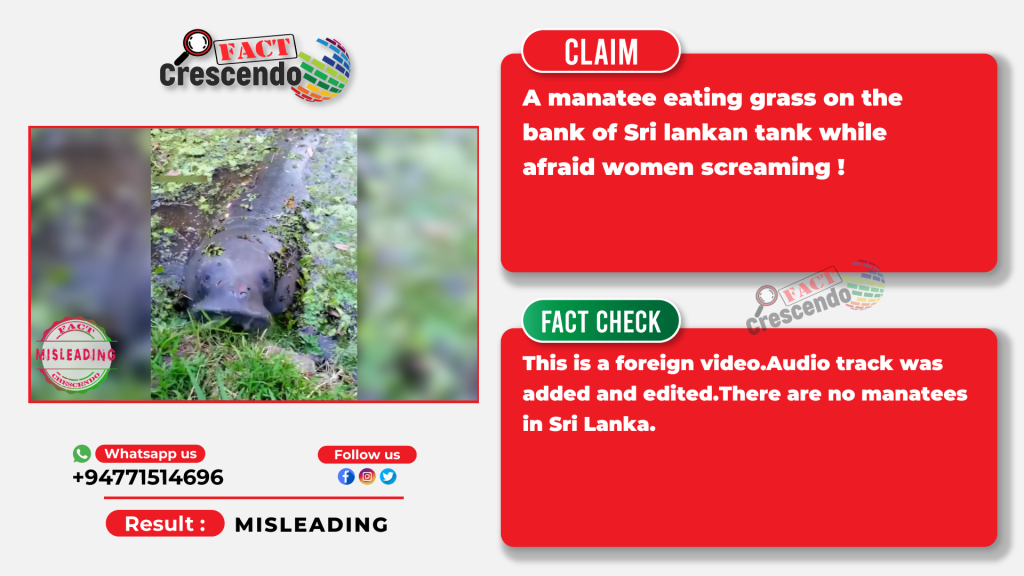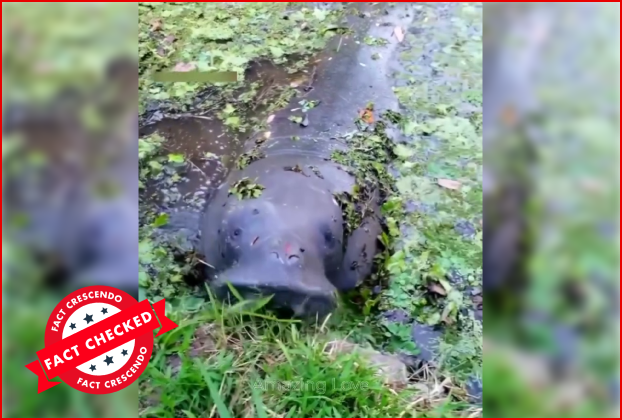
දිනපතා සත්ය කරුණු දැන ගැනීමට අපගේ WhatsApp සමුහයටමෙතනින් එකතුවන්න.
Many people are fascinated by unusual and exotic animals, leading to a surge in social media posts showcasing these creatures. However, it’s essential to be cautious as some of these posts may be misleading or entirely false. In this investigation, we’ll delve into a particular social media post featuring a peculiar animal, the manatee, to separate fact from fiction.
Social Media posts
A video circulating on social media depicts a large aquatic animal, identified as a manatee, peacefully eating grass at the bank of a reservoir in Sri Lanka. The video accompanying the voice particularly a group of women screaming in Sinhala as they got afraid to animal.
Users commented to it like below.

We decided to do a fact check on this.
Fact Check:
Manipulated Audio: The audio in the video has been manipulated. This is evidenced by the presence of the same video circulating internationally on social media platforms with different audio tracks over some time. The original video content has been altered to convey a false narrative and induce fear.Such a video can be reached here We also noticed a same video uploaded to foreign YouTube channel 3 years before with different sound track.It can be watched below.
Identification of the Animal: The animal in the video is correctly identified as a manatee. Manatees are aquatic mammals belonging to the Sirenia family and are primarily found in fresh and sometimes salty water. Three species of manatees exist: West Indian manatee (found from Florida to Brazil), Amazonian manatee (found in the Amazon River), and African manatee (residing along the west coast of Africa).More details about manatees can be read here
Expert Opinion: Dr. Ranil Nanayakkara, a conservation biologist specializing in Terrestrial and marine mammals , has confirmed that the animal in the video is most likely a West Indian manatee. He emphasized that manatees are not native to Sri Lanka, and there is no fossil evidence suggesting their historical presence in the country. And he further added they are not living in Sri Lanka or at least not seasonally migrating to coastal waters here in anyways .The video was likely recorded in a foreign country ,he added..
Difference Between Manatees and Dugongs: Dr. Nanayakkara highlights the difference between manatees and dugongs, both belonging to the Sirenia family and mammals . While they share similarities in appearance and behavior, a key distinction is in their tails. Manatees have paddle-shaped tails, whereas dugongs have fluked tails, resembling a whale-like appearance.And while menatees mostly fresh water species, dudongs mostly a marine species.More details can be read here
Presence of Dugongs in Sri Lanka: Although manatees cannot be found in Sri Lanka, Dr. Nanayakkara notes that dugongs, another species within the Sirenia family, can be found in some coastal areas of the country. In the early 1900s, there were reports of substantial dugong herds in the Palk Strait, situated between India and Sri Lanka. Consequently, the currently number of dugongs living in this region remain uncertain. Although sightings of dugongs are rare, there are reports of dugong killings occurring at least once a month in the Mnanar and Pork Strait areas of the country, according to Dr. Nanayakkara. He emphasized that no sightings or reports of killings have been documented in other regions of the country, such as the southern province or western areas. However, he noted the existence of fossil evidence in eastern regions, where a significant number of sea grass beds still exist. Additionally, Dr. Nanayakkara explained that dugongs exhibit a preference for shallow waters, primarily due to the prevalence of sea grass beds in those areas. He emphasized, however, that they are not hesitant to navigate in deeper waters and are known to undertake extensive migrations over long distances. Dr. Nanayakkara emphasizes the crucial role played by dugongs in certain seagrass bed ecosystems where they reside. Numerous animal and plant species rely on the excretions of dugongs for sustenance, highlighting their ecological significance. Furthermore, Dr. Nanayakkara underscores that the presence of dugongs is vital for the health of the planet due to their contribution to carbon sequestration and the carbon cycle within seagrass beds. In essence, the prevalence of dugongs is essential for maintaining the overall ecological balance and well-being of the Earth. More about a dugong conservation project in Sri Lanka can be read here
Conservation Status: . Both manatees and dugongs are herbivorous animals and are protected as endangered species under international law Dr. Nanayakkara emphasizes that manatees, particularly in Africa, face threats such as being killed for meat. Despite legal protection, these animals are are facing threats such as entanglement in fishing nets and collisions with boats. It’s crucial to highlight that manatees are not native to Sri Lanka, and there is no possibility of encountering them in Sri Lankan freshwater reservoirs or marine ecosystems.
Follow us and stay up to date with our latest fact checks.
Facebook | Twitter |Instagram | Google News | TikTok
Conclusion
The video in question shows a manatee, not native to Sri Lanka, those animals not living in Sri Lanka and the accompanying audio has been manipulated. The expert opinion of Dr. Ranil Nanayakkara supports the fact that this video was recorded in a foreign country, and the animal is most likely a West Indian manatee. In this article, we provide information on manatees, dugongs, and their conservation status, emphasizing the threats faced by manatees in certain regions, including Africa.

Title:Fact Check: Video of A large Aquatic Animal Eating Grass in Sri Lanka
Written By: Kalana KrishanthaResult: Misleading






